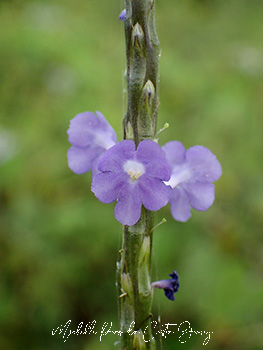This post is also available in: Dutch (below)

If you want hummingbirds in your garden you need this plant in your garden. The Blue porterweed is a much loved garden plant for all who want to attract hummingbirds and butterflies to the garden. It is used widely in the cultivation of garden plants but not many people know that the plant occurs naturally in the wild on Curaçao, also attracting hummingbirds, butterflies and load of other insects. It loves areas with a little bit of moisture but can also be found along roadsides and other disturbed areas. When not flowering it is often overlooked and taken out as a weed, as the plant tends not to grow very elegantly in the wild.
The delicate violet flowers of this plant are only about 5 to 6 mm long and have a lighter colour in the centre than on the petals. The flowers are perfectly formed to fit a hummingbird bill, gently pressing the pollen on the head or neck of the bird when it enters the flower with its bill to get at the nectar inside. Bananaquits who do not have the right bill form or size often make an extra hole on the side to get to the nectar, often destroying the entire flower in the process.
The Bibirito is a native plant to the Caribbean and used on many islands as a medicinal plant, although research has seen that the plant also causes certain toxicity issues in the human body.
English name: Blue porterweed / Jamaican vervain / Brazilian tea
Papiamentu/Papiamento name: Bibirito / Kai-flou (Aruba: Raspa biña)
Scientific name: Stachytarpheta jamaicensis
Family: Verbenaceae (Verbena family)
Occurrence (ABC islands): Aruba (status unclear), Bonaire and Curaçao

Wilde bloemen: Bibirito
Als je kolibries in je tuin wilt in de Caribbean, heb je deze plant nodig. De Bibirito is een geliefde tuinplant voor iedereen die kolibries en vlinders naar de tuin wil lokken. De plant wordt veel gebruikt bij de teelt van tuinplanten, maar niet veel mensen weten dat de plant van nature in het wild voorkomt op Bonaire en Curaçao en ook kolibries, vlinders en een heleboel andere insecten aantrekt. De plant houdt van gebieden met een beetje vocht, maar kan ook langs wegen en andere verstoorde gebieden worden gevonden. Als hij niet bloeit, wordt hij vaak over het hoofd gezien en als onkruid verwijderd, omdat de plant in het wild niet erg elegant groeit.

De delicate violette bloemen van deze plant zijn slechts ongeveer 5 tot 6 mm lang en hebben een lichtere kleur in het midden dan op de bloemblaadjes. De bloemen zijn perfect gevormd voor de vorm van een kolibriesnavel, waarbij ze zachtjes het stuifmeel op de kop of nek van de vogel drukken wanneer het dier met de snavel de bloem binnengaat om bij de nectar te komen. Suikerdiefjes, die niet de juiste snavelvorm of -grootte hebben, maken vaak een extra gat aan de zijkant om bij de nectar te komen, waarbij ze vaak de hele bloem kapot maken.
De Bibirito is een inheemse plant in het Caribisch gebied en wordt op veel eilanden gebruikt als medicinale plant, hoewel onderzoek heeft aangetoond dat de plant ook bepaalde toxiciteitsproblemen in het menselijk lichaam veroorzaakt.
Nederlandse naam: –
Papiamentse naam: Bibirito / Kai-flou (Aruba: Raspa biña)
Wetenschappelijke naam: Stachytarpheta jamaicensis
Familie: Verbenaceae (Ijzerhardfamilie)
Voorkomen (ABC eilanden): Aruba (status onduidelijk), Bonaire en Curaçao